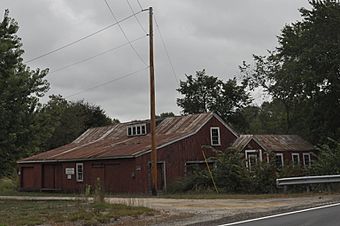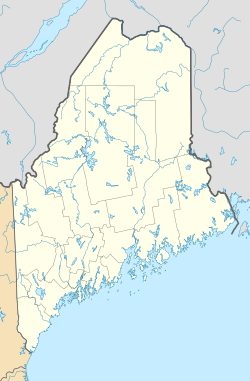Dennis Johnson Lumber Company Mill facts for kids
Quick facts for kids |
|
|
Dennis Johnson Lumber Company Mill
|
|
 |
|
| Location | NE side of ME 5, 0.3 mi. N of Silas Brown Rd., Waterboro, Maine |
|---|---|
| Area | 0.5 acres (0.20 ha) |
| Built | 1902 |
| Architect | Dennis Johnson |
| Architectural style | Concrete Arch Bridge |
| NRHP reference No. | 07000409 |
| Added to NRHP | May 8, 2007 |
The Dennis Johnson Lumber Company Mill is a really old and important building in Waterboro, Maine. For almost 100 years, starting in 1869, a lumber mill worked here. It first used water power, then steam power.
This place is special because much of its old equipment is still inside, even though it closed in 1963. It's rare to find such an old industrial building in a small town. The local historical society now owns the mill. They hope to turn it into a museum. Because it's so important, it was added to the National Register of Historic Places in 2007.
Contents
What Does the Mill Look Like?
The Johnson Mill is on the north side of Maine State Route 5. It's just south of a small area called North Waterboro village.
The Mill Pond and Bridge
The mill pond is on the south side of the highway. A concrete bridge crosses over Johnson Stream. Dennis Johnson, who owned the mill, built this bridge in 1920. The old mill dam, which helped power the mill, is now broken. It lies almost under the bridge.
The Main Mill Building
The main mill building was built in 1902. It has three parts. The biggest part is a 1-1/2 story wooden building with a pointy roof. It has a smaller, slanted roof section on its west side.
Another part of the building sticks out over the stream. This single-story section has a pointy roof that runs parallel to the highway. The main building sits on a strong concrete base. The part over the stream is held up by concrete pillars.
Inside the Mill
The mill building doesn't have a clear main door. On the side facing the street, there's a small door for people. There's also a bigger opening with a ramp for moving wood. The west side has a large sliding door. Other parts of the west side can open up. This lets in more light and fresh air. The north side has two doors for utilities.
Inside, you can see the wooden frame of the walls. The floors are made of wood planks. A big machine called a bandsaw is in the eastern part. It was made by the Berlin Machine Works. There's also a crosscut saw to trim the ends of wood. An edger/jointer shapes the wood edges. A planer makes the wood smooth. A winch helps move big pieces of lumber.
The southeast part of the building has the "file room." This is where saw blades were kept and sharpened. In the basement, you can still see parts of a large steam boiler. This machine used steam to power the mill.
A Look Back: The Mill's History
Dennis Johnson started the mill in 1869 when he was 23 years old. In 1870, the mill made 40,000 pine shingles in just four months.
Growth and Changes
The Johnson Mill was one of six mills in Waterboro. They usually processed wood cut from local forests. The mill's output grew a lot around 1900. This was when they started using steam power. The mill employed up to twelve workers.
Dennis Johnson built the current building to replace an older mill. The old mill looked a bit worn out in 1890. In 1947, a big fire swept through Waterboro. It destroyed many buildings and forests. But the Dennis Johnson Mill was the only one in town to survive!
Closing and New Life
Dennis Johnson's grandson, Donald, closed the mill in 1963. In 1974, the Waterboro Historic Society bought the mill. They are working to preserve it. They hope to open it as a museum one day. This will help people learn about the history of lumber and industry in Maine.



